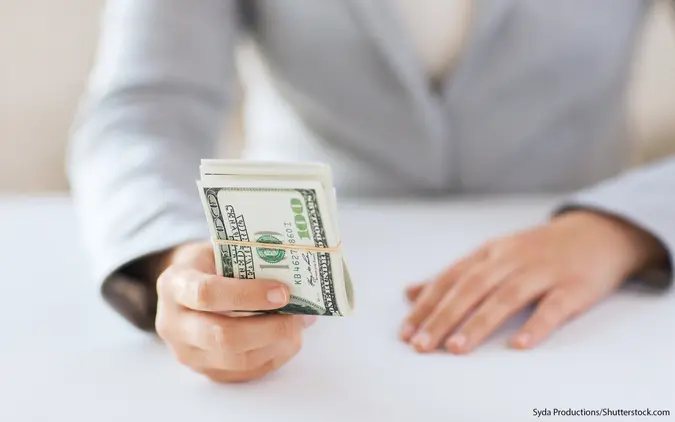Your $20 Bill May Be Worth Bigger Bucks: How To Look Up the Serial Number

Commitment to Our Readers
GOBankingRates' editorial team is committed to bringing you unbiased reviews and information. We use data-driven methodologies to evaluate financial products and services - our reviews and ratings are not influenced by advertisers. You can read more about our editorial guidelines and our products and services review methodology.

20 Years
Helping You Live Richer

Reviewed
by Experts

Trusted by
Millions of Readers
There are worse things than having a wallet stuffed with $20 bills, especially in this economy. But did you ever stop to consider that those twenties in your pocket could be worth more than their face value?
Although most of your paper money won’t be worth more than what it says, there’s a chance it might — even if it’s not decades old — based on the serial number. To find the value, or find out if your $20 bill is valuable, you’ll need to do a little bit of research.
Read on to learn more about the $20 bill serial number lookup process for the cash you already have on hand so you can find out if it’s worth more than Andrew Jackson would have you believe. Here are a few steps you can take to check.
Step 1: Look Up a Serial Number on Your Bill
One way to look up a serial number on a bill is to use an online tool, such as Fancy Serial Number Checker or Banknote Serial Checker. For example, on Banknote Serial Checker, you simply enter the $20 bill’s information and other details so you can find out if it’s common or rare. The tool even provides a link to eBay where you can see bills similar to yours for sale.
If your bill appears to be worth more than face value from your research and you want to sell it, you could list it for sale on eBay. You could also hang on to it as part of your cash stash at home.
An alternative to eBay is Heritage Auctions, where you can look up what different types of currency have sold for. Other ways to look up serial numbers on money include reference books, a currency or coin dealer and currency forums.
Up Next: Do You Have a $2K Quarter? Look Closely Before You Spend This 2004 Coin
Wait, What Is a Serial Number?
Sorry, let’s back up. A serial number is a unique combination of 11 numbers and letters that appears twice in different places on the front of the bill. The first letter indicates the series year, also known as the year in which the Secretary of the Treasury approved a new design. The year listed could also be the year that the signature of a new secretary or treasurer was added to the design.
In 1996, the serial numbers on Federal Reserve notes began with two letters instead of one. The first letter corresponds to the series year. The second letter, ranging from A-L, indicates the issuing Federal Reserve Bank. The last letter in the serial number is anything but O, which is too close to zero or Z, which is used in test printings.
Through 1995, all Federal Reserve notes had serial numbers composed of the following:
- One letter at the beginning. This indicates the series year.
- Eight digits.
- One letter at the end. According to the Bureau of Engraving and Printing, this letter advances through the alphabet once all eight-character serial numbers have been printed for a specific Federal Reserve Bank within a series. When the series changes, the ending letter returns to “A” and repeats the cycle.
- An example would be A24687321B. However, only $1 and $2 notes still use this format.
Series Year
The first letters in a serial number correspond to a year. Here’s a breakdown:
- A: 1996
- B: 1999
- C: 2001
- D: 2003
- E: 2004
- F: 2003A
- G: 2004A
- H: 2006
- I: 2006
- J: 2009
- K: 2006A
- L: 2009A
- M: 2013
- N: 2017
- P: 2017A
- Q: 2021
U.S. Federal Reserve Indicators
The location of the U.S. Federal Reserve indicator on each note or bill depends on its denomination.
For example, bills or notes in the following denominations — $5, $10, $20, $50 and $100 — have a letter and number indicator that’s printed in a different place than the serial number, such as E5. The letter in the indicator, such as “E,” is also the second letter of the serial number on the previously mentioned denominations. The number in the indicator, such as “5” is the corresponding number of the federal reserve bank.
For $1 and $2 notes, each note has a seal printed on it with a letter in the middle and a number to the side, such as “E” and “5.” This indicates one of the 12 Federal Reserve banks.
Here are the U.S. Federal Reserve indicators and their corresponding banks.
- A1: Boston
- B2: New York
- C3: Philadelphia
- D4: Cleveland
- E5: Richmond, Va.
- F6: Atlanta
- G7: Chicago
- H8: St. Louis
- I9: Minneapolis
- J10: Kansas City, Mo.
- K11: Dallas
- L12: San Francisco
Step 2: Check the Star Notes
Some notes have a star in place of the ending letter. This occurs when an imperfect sheet is found during the manufacturing process and needs to be replaced with a star sheet.
Star notes or bills have their own unique serial number with a star in place of the last letter. Star notes could prove to be more valuable than notes without stars.
Step 3: See If Your Bill Has a Fancy Serial Number
According to PMG, This type of number is considered a special serial number, such as repeaters and super pedigrees. Bills or notes with this format are considered to be more valuable.
Here are the types of fancy serial numbers PMG recognizes:
- Super pedigrees: When the number prefix is what makes the serial number super.
- Combinations: When fancy serial numbers are combined together, such as radar, repeater and rotator.
- Rotator serial number: When the number doesn’t change when read upside down.
- Solid serial number: The entire number is made up of the same number except for the prefix.
- Serial number 1-10: A number that is one of the first 10 notes printed.
- Repeater serial number: At least two digits repeat at least two times within the number series.
- Radar serial number: A number that reads the same forward and backward.
- 81 million serial number: A number with a number 1-100 followed by six zeros.
- Binary serial number: Serial numbers that only contain ones and zeroes.
- Ascending and descending ladder serial numbers: These numbers increase from low to high or high to low.
Caitlyn Moorhead contributed to the reporting for this article.
More From GOBankingRates
Our in-house research team and on-site financial experts work together to create content that’s accurate, impartial, and up to date. We fact-check every single statistic, quote and fact using trusted primary resources to make sure the information we provide is correct. You can learn more about GOBankingRates’ processes and standards in our editorial policy.
- U.S. Currency Education Program. "Banknote Identifiers and Symbols."
- Paper Money Guaranty. 2017. "Fancy Serial Numbers On Currency."
- The Bureau of Engraving and Printing. "Serial Numbers."
- My Currency Collection. "What Is My Note Worth?"
 Written by
Written by  Edited by
Edited by 

























